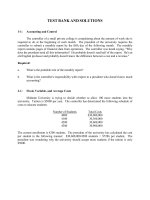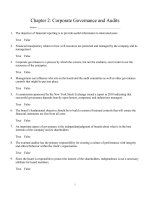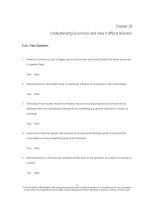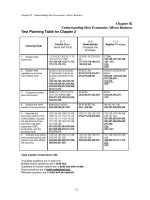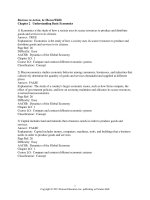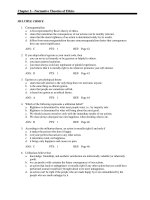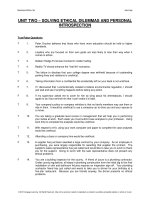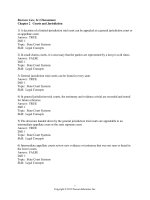Business statistics in practice 8th edition bowerman test bank
Bạn đang xem bản rút gọn của tài liệu. Xem và tải ngay bản đầy đủ của tài liệu tại đây (831.85 KB, 53 trang )
Chapter 02 Test Bank - Static KEY
1.
A stem-and-leaf display is a graphical portrayal of a data set that shows the data set's overall
pattern of variation.
TRUE
AACSB: Reflective Thinking
Blooms: Remember
Difficulty: 2 Medium
Learning Objective: 02-05 Construct and interpret stem-and-leaf displays.
Topic: Stem-and-Leaf Displays
2.
The relative frequency is the frequency of a class divided by the total number of measurements.
TRUE
AACSB: Reflective Thinking
Blooms: Remember
Difficulty: 2 Medium
Learning Objective: 02-03 Summarize quantitative data using frequency distributions, histograms, frequency polygons, and ogives.
Topic: Graphically Summarizing Qualitative Data
3.
A bar chart is a graphic that can be used to depict qualitative data.
TRUE
AACSB: Reflective Thinking
Blooms: Remember
Difficulty: 1 Easy
Learning Objective: 02-01 Summarize qualitative data by using frequency distributions, bar charts, and pie charts.
Topic: Graphically Summarizing Qualitative Data
4.
Stem-and-leaf displays and dot plots are useful for detecting outliers.
TRUE
AACSB: Reflective Thinking
Blooms: Remember
Difficulty: 2 Medium
Learning Objective: 02-04 Construct and interpret dot plots.
Learning Objective: 02-05 Construct and interpret stem-and-leaf displays.
Topic: Dot Plots
Topic: Stem-and-Leaf Displays
5.
A scatter plot can be used to identify outliers.
FALSE
A scatter plot is used to identify the relationship between two variables.
AACSB: Reflective Thinking
Blooms: Remember
Difficulty: 2 Medium
Learning Objective: 02-07 Examine the relationships between variables by using scatter plots.
Topic: Scatter Plots
6.
When looking at the shape of the distribution using a stem-and-leaf, a distribution is skewed to
the right when the left tail is shorter than the right tail.
2-1
Copyright © 2017 McGraw-Hill Education. All rights reserved. No reproduction or distribution without the prior written consent of
McGraw-Hill Education.
TRUE
AACSB: Reflective Thinking
Blooms: Remember
Difficulty: 2 Medium
Learning Objective: 02-05 Construct and interpret stem-and-leaf displays.
Topic: Stem-and-Leaf Displays
7.
When we wish to summarize the proportion (or fraction) of items in a class, we use the frequency
distribution for each class.
FALSE
This is the definition for relative frequency. Frequency distribution shows actual counts of
items in a class.
AACSB: Reflective Thinking
Blooms: Remember
Difficulty: 2 Medium
Learning Objective: 02-03 Summarize quantitative data using frequency distributions, histograms, frequency polygons, and ogives.
Topic: Graphically Summarizing Qualitative Data
8.
When establishing the classes for a frequency table, it is generally agreed that the more classes
you use the better your frequency table will be.
FALSE
Classes should be determined by the number of data measurements.
AACSB: Reflective Thinking
Blooms: Remember
Difficulty: 1 Easy
Learning Objective: 02-03 Summarize quantitative data using frequency distributions, histograms, frequency polygons, and ogives.
Topic: Graphically Summarizing Qualitative Data
9.
The sample cumulative distribution function is nondecreasing.
TRUE
AACSB: Reflective Thinking
Blooms: Remember
Difficulty: 2 Medium
Learning Objective: 02-03 Summarize quantitative data using frequency distributions, histograms, frequency polygons, and ogives.
10.
A frequency table includes row and column percentages.
FALSE
Frequency tables include frequencies, relative frequency, and percent frequency. Crosstabulation tables include row and column percentages.
AACSB: Reflective Thinking
Blooms: Remember
Difficulty: 2 Medium
Learning Objective: 02-01 Summarize qualitative data by using frequency distributions, bar charts, and pie charts.
Learning Objective: 02-03 Summarize quantitative data using frequency distributions, histograms, frequency polygons, and ogives.
Topic: Graphically Summarizing Qualitative Data
Topic: Graphically Summarizing Quantitative Data
11. When constructing any graphical display that utilizes categorical data, classes that have
frequencies of 5 percent or less are usually combined together into a single category.
2-2
Copyright © 2017 McGraw-Hill Education. All rights reserved. No reproduction or distribution without the prior written consent of
McGraw-Hill Education.
TRUE
AACSB: Reflective Thinking
Blooms: Remember
Difficulty: 2 Medium
Learning Objective: 02-02 Construct and interpret Pareto charts.
Topic: Graphically Summarizing Qualitative Data
12. In a Pareto chart, the bar for the "Other" category should be placed to the far left of the chart.
FALSE
The bar to the far left of the Pareto chart will be the category with the highest frequency.
AACSB: Reflective Thinking
Blooms: Remember
Difficulty: 1 Easy
Learning Objective: 02-02 Construct and interpret Pareto charts.
Topic: Graphically Summarizing Qualitative Data
13. In the first step of setting up a Pareto chart, a frequency table should be constructed of the
defects (or categories) in decreasing order of frequency.
TRUE
AACSB: Reflective Thinking
Blooms: Remember
Difficulty: 2 Medium
Learning Objective: 02-02 Construct and interpret Pareto charts.
Topic: Graphically Summarizing Qualitative Data
14. It is possible to create different interpretations of the same graphical display by simply using
different captions.
TRUE
AACSB: Reflective Thinking
Blooms: Remember
Difficulty: 2 Medium
Learning Objective: 02-08 Recognize misleading graphs and charts.
Topic: Misleading Graphs and charts
15. Beginning the vertical scale of a graph at a value different from zero can cause increases to look
more dramatic.
TRUE
AACSB: Reflective Thinking
Blooms: Remember
Difficulty: 2 Medium
Learning Objective: 02-08 Recognize misleading graphs and charts.
Topic: Misleading Graphs and charts
16. A runs plot is a form of scatter plot.
TRUE
AACSB: Reflective Thinking
Blooms: Remember
Difficulty: 1 Easy
Learning Objective: 02-07 Examine the relationships between variables by using scatter plots.
Topic: Scatter Plots
2-3
Copyright © 2017 McGraw-Hill Education. All rights reserved. No reproduction or distribution without the prior written consent of
McGraw-Hill Education.
17. The stem-and-leaf display is advantageous because it allows us to actually see the
measurements in the data set.
TRUE
AACSB: Reflective Thinking
Blooms: Remember
Difficulty: 1 Easy
Learning Objective: 02-05 Construct and interpret stem-and-leaf displays.
Topic: Stem-and-Leaf Displays
18. Splitting the stems refers to assigning the same stem to two or more rows of the stem-and-leaf
display.
TRUE
AACSB: Reflective Thinking
Blooms: Remember
Difficulty: 2 Medium
Learning Objective: 02-05 Construct and interpret stem-and-leaf displays.
Topic: Stem-and-Leaf Displays
19. When data are qualitative, the bars should never be separated by gaps.
FALSE
Bar graphs for qualitative data are displayed with a gap between each category.
AACSB: Reflective Thinking
Blooms: Remember
Difficulty: 2 Medium
Learning Objective: 02-01 Summarize qualitative data by using frequency distributions, bar charts, and pie charts.
Topic: Graphically Summarizing Quantitative Data
20. Each stem of a stem-and-leaf display should be a single digit.
FALSE
Leaves on the stem-and-leaf are a single digit.
AACSB: Reflective Thinking
Blooms: Remember
Difficulty: 2 Medium
Learning Objective: 02-05 Construct and interpret stem-and-leaf displays.
Topic: Stem-and-Leaf Displays
21. Leaves on a stem-and-leaf display should be rearranged so that they are in increasing order from
left to right.
TRUE
AACSB: Reflective Thinking
Blooms: Remember
Difficulty: 2 Medium
Learning Objective: 02-05 Construct and interpret stem-and-leaf displays.
Topic: Stem-and-Leaf Displays
2-4
Copyright © 2017 McGraw-Hill Education. All rights reserved. No reproduction or distribution without the prior written consent of
McGraw-Hill Education.
22. Gauges feature a single measure showing variation over time.
FALSE
Sparklines feature a single measure showing variation over time.
AACSB: Reflective Thinking
Blooms: Remember
Difficulty: 2 Medium
Learning Objective: 02-09 Construct and interpret gauges, bullet graphs, treemaps, and sparklines.
Topic: Descriptive Analytics
23. Data drill down is a form of data discovery.
TRUE
AACSB: Reflective Thinking
Blooms: Remember
Difficulty: 1 Easy
Learning Objective: 02-09 Construct and interpret gauges, bullet graphs, treemaps, and sparklines.
Topic: Descriptive Analytics
24. Treemaps are used to display qualitative measures of performance.
FALSE
Treemaps help visualize two variables on quantitative measures.
AACSB: Reflective Thinking
Blooms: Remember
Difficulty: 2 Medium
Learning Objective: 02-09 Construct and interpret gauges, bullet graphs, treemaps, and sparklines.
Topic: Descriptive Analytics
25. Sparklines always need to be displayed with either their axes or coordinates.
FALSE
Sparklines seldom show their axes or coordinates.
AACSB: Reflective Thinking
Blooms: Remember
Difficulty: 2 Medium
Learning Objective: 02-09 Construct and interpret gauges, bullet graphs, treemaps, and sparklines.
Topic: Descriptive Analytics
2-5
Copyright © 2017 McGraw-Hill Education. All rights reserved. No reproduction or distribution without the prior written consent of
McGraw-Hill Education.
26. A bullet graph features a single measure as either a horizontal or vertical bar.
TRUE
AACSB: Reflective Thinking
Blooms: Remember
Difficulty: 1 Easy
Learning Objective: 02-09 Construct and interpret gauges, bullet graphs, treemaps, and sparklines.
Topic: Descriptive Analytics
27. Key performance indicators are best represented by a data discovery method.
FALSE
KPIs are best represented by an analytic dashboard.
AACSB: Reflective Thinking
Blooms: Remember
Difficulty: 3 Hard
Learning Objective: 02-09 Construct and interpret gauges, bullet graphs, treemaps, and sparklines.
Topic: Descriptive Analytics
28. A treemap graphic is a series of clustered rectangles.
TRUE
AACSB: Reflective Thinking
Blooms: Remember
Difficulty: 1 Easy
Learning Objective: 02-09 Construct and interpret gauges, bullet graphs, treemaps, and sparklines.
Topic: Descriptive Analytics
29. Sparklines are line charts often embedded with the text where they are being discussed.
TRUE
AACSB: Reflective Thinking
Blooms: Remember
Difficulty: 2 Medium
Learning Objective: 02-09 Construct and interpret gauges, bullet graphs, treemaps, and sparklines.
Topic: Descriptive Analytics
2-6
Copyright © 2017 McGraw-Hill Education. All rights reserved. No reproduction or distribution without the prior written consent of
McGraw-Hill Education.
30. An analytic dashboard presents both current and historical trends of a business’s key
performance indicators.
TRUE
AACSB: Reflective Thinking
Blooms: Remember
Difficulty: 2 Medium
Learning Objective: 02-09 Construct and interpret gauges, bullet graphs, treemaps, and sparklines.
Topic: Descriptive Analytics
31. If space is an issue when presenting analytic dashboard graphics, gauges should be used most
frequently.
FALSE
Gauges take up considerable space and are cluttered.
AACSB: Reflective Thinking
Blooms: Remember
Difficulty: 3 Hard
Learning Objective: 02-09 Construct and interpret gauges, bullet graphs, treemaps, and sparklines.
Topic: Descriptive Analytics
32. Which of the following is not a graphical tool for descriptive analytics (dashboards)?
A.
B.
C.
D.
E.
bullet graph
sparkline
scatter plot
treemap
gauge
AACSB: Reflective Thinking
Blooms: Remember
Difficulty: 1 Easy
Learning Objective: 02-09 Construct and interpret gauges, bullet graphs, treemaps, and sparklines.
Topic: Descriptive Analytics
33. A(n) _____________ is a graphical presentation of the current status and historical trends of a
business’s key performance indicators.
A.
B.
C.
D.
frequence distribution
histogram
Pareto chart
dashboard
AACSB: Reflective Thinking
Blooms: Remember
Difficulty: 2 Medium
2-7
Copyright © 2017 McGraw-Hill Education. All rights reserved. No reproduction or distribution without the prior written consent of
McGraw-Hill Education.
Learning Objective: 02-09 Construct and interpret gauges, bullet graphs, treemaps, and sparklines.
Topic: Descriptive Analytics
34. As a business owner, I have requested my staff to develop a set of dashboards that can be used
by the public to show wait time at each of my four local coffee shops at peak times during the day
and whether the time is short, medium, or long. Which of the following graphical displays would
be the best choice?
A.
B.
C.
D.
bullet graph
sparkline
treemap
gauges
AACSB: Reflective Thinking
Blooms: Remember
Difficulty: 3 Hard
Learning Objective: 02-09 Construct and interpret gauges, bullet graphs, treemaps, and sparklines.
Topic: Descriptive Analytics
35. Which of the following is the best analytic dashboard graphical method for visualizing hierarchical
information?
A.
B.
C.
D.
bullet graph
sparkline
treemap
gauge
AACSB: Reflective Thinking
Blooms: Remember
Difficulty: 2 Medium
Learning Objective: 02-09 Construct and interpret gauges, bullet graphs, treemaps, and sparklines.
Topic: Descriptive Analytics
36. Which of the following dashboard graphical methods will show variation over time?
A.
B.
C.
D.
bullet graph
sparkline
treemap
gauge
AACSB: Reflective Thinking
Blooms: Remember
Difficulty: 2 Medium
Learning Objective: 02-09 Construct and interpret gauges, bullet graphs, treemaps, and sparklines.
Topic: Descriptive Analytics
37. A(n) ______ is a graph of a cumulative distribution.
A.
B.
C.
D.
histogram
scatter plot
ogive plot
pie chart
AACSB: Reflective Thinking
2-8
Copyright © 2017 McGraw-Hill Education. All rights reserved. No reproduction or distribution without the prior written consent of
McGraw-Hill Education.
Blooms: Remember
Difficulty: 2 Medium
Learning Objective: 02-03 Summarize quantitative data using frequency distributions, histograms, frequency polygons, and ogives.
38. ________ can be used to study the relationship between two variables.
A. Cross-tabulation tables
B. Frequency tables
C. Cumulative frequency distributions
D. Dot plots
AACSB: Reflective Thinking
Blooms: Remember
Difficulty: 1 Easy
Learning Objective: 02-06 Examine the relationships between variables by using contingency tables.
Topic: Contingency Tables
39. Row or column percentages can be found in
A.
B.
C.
D.
frequency tables.
relative frequency tables
cross-tabulation tables.
cumulative frequency tables.
AACSB: Reflective Thinking
Blooms: Remember
Difficulty: 2 Medium
Learning Objective: 02-06 Examine the relationships between variables by using contingency tables.
Topic: Contingency Tables
40. All of the following are used to describe quantitative data except the ___________.
A.
B.
C.
D.
histogram
stem-and-leaf chart
dot plot
pie chart
AACSB: Reflective Thinking
Blooms: Remember
Difficulty: 2 Medium
Learning Objective: 02-03 Summarize quantitative data using frequency distributions, histograms, frequency polygons, and ogives.
Topic: Graphically Summarizing Quantitative Data
41. An observation separated from the rest of the data is a(n) ___________.
A.
B.
C.
D.
absolute extreme
outlier
mode
quartile
AACSB: Reflective Thinking
Blooms: Remember
Difficulty: 1 Easy
Learning Objective: 02-05 Construct and interpret stem-and-leaf displays.
Topic: Stem-and-Leaf Displays
2-9
Copyright © 2017 McGraw-Hill Education. All rights reserved. No reproduction or distribution without the prior written consent of
McGraw-Hill Education.
42. Which of the following graphs is for qualitative data?
A. histogram
B. bar chart
C. ogive plot
D. stem-and-leaf
AACSB: Reflective Thinking
Blooms: Remember
Difficulty: 2 Medium
Learning Objective: 02-01 Summarize qualitative data by using frequency distributions, bar charts, and pie charts.
Topic: Graphically Summarizing Qualitative Data
43. A plot of the values of two variables is a _____ plot.
A. runs
B. scatter
C. dot
D. ogive
AACSB: Reflective Thinking
Blooms: Remember
Difficulty: 2 Medium
Learning Objective: 02-07 Examine the relationships between variables by using scatter plots.
Topic: Scatter Plots
44. A Stem-and-leaf display is best used to ___________.
A.
B.
C.
D.
provide a point estimate of the variability of the data set
provide a point estimate of the central tendency of the data set
display the shape of the distribution
None of the other choices is correct.
AACSB: Reflective Thinking
Blooms: Remember
Difficulty: 2 Medium
Learning Objective: 02-05 Construct and interpret stem-and-leaf displays.
Topic: Stem-and-Leaf Displays
45. When grouping a large sample of measurements into classes, the ______________ is a better
tool than the ___________.
A.
B.
C.
D.
histogram, stem-and-leaf display
box plot, histogram
stem-and-leaf display, scatter plot
scatter plot, box plot
AACSB: Reflective Thinking
Blooms: Understand
Difficulty: 3 Hard
Learning Objective: 02-03 Summarize quantitative data using frequency distributions, histograms, frequency polygons, and ogives.
Topic: Graphically Summarizing Quantitative Data
2-10
Copyright © 2017 McGraw-Hill Education. All rights reserved. No reproduction or distribution without the prior written consent of
McGraw-Hill Education.
46. A _____________ displays the frequency of each group with qualitative data and a
_____________ displays the frequency of each group with quantitative data.
A.
B.
C.
D.
histogram, stem-and-leaf display
bar chart, histogram
scatter plot, bar chart
stem-and-leaf, pie chart
AACSB: Reflective Thinking
Blooms: Remember
Difficulty: 2 Medium
Learning Objective: 02-01 Summarize qualitative data by using frequency distributions, bar charts, and pie charts.
Learning Objective: 02-03 Summarize quantitative data using frequency distributions, histograms, frequency polygons, and ogives.
Topic: Graphically Summarizing Qualitative Data
Topic: Graphically Summarizing Quantitative Data
47. A ______________ shows the relationship between two variables.
A.
B.
C.
D.
E.
stem-and-leaf
bar chart
histogram
scatter plot
pie chart
AACSB: Reflective Thinking
Blooms: Remember
Difficulty: 2 Medium
Learning Objective: 02-07 Examine the relationships between variables by using scatter plots.
Topic: Scatter Plots
48. A ______________ can be used to differentiate the "vital few" causes of quality problems from
the "trivial many" causes of quality problems.
A.
B.
C.
D.
E.
histogram
scatter plot
Pareto chart
ogive plot
stem-and-leaf display
AACSB: Reflective Thinking
Blooms: Remember
Difficulty: 2 Medium
Learning Objective: 02-02 Construct and interpret Pareto charts.
Topic: Graphically Summarizing Qualitative Data
2-11
Copyright © 2017 McGraw-Hill Education. All rights reserved. No reproduction or distribution without the prior written consent of
McGraw-Hill Education.
49. ______________ and _____________ are used to describe qualitative (categorical) data.
A.
B.
C.
D.
E.
Stem-and-leaf displays, scatter plots
Scatter plots, histograms
Box plots, bar charts
Bar charts, pie charts
Pie charts, histograms
AACSB: Reflective Thinking
Blooms: Remember
Difficulty: 2 Medium
Learning Objective: 02-01 Summarize qualitative data by using frequency distributions, bar charts, and pie charts.
Topic: Graphically Summarizing Qualitative Data
50. Which one of the following graphical tools is used with quantitative data?
A.
B.
C.
D.
bar chart
histogram
pie chart
Pareto chart
AACSB: Reflective Thinking
Blooms: Remember
Difficulty: 2 Medium
Learning Objective: 02-03 Summarize quantitative data using frequency distributions, histograms, frequency polygons, and ogives.
Topic: Graphically Summarizing Quantitative Data
51. When developing a frequency distribution, the class (group) intervals should be ___________.
A.
B.
C.
D.
E.
large
small
integer
mutually exclusive
equal
AACSB: Reflective Thinking
Blooms: Remember
Difficulty: 3 Hard
Learning Objective: 02-03 Summarize quantitative data using frequency distributions, histograms, frequency polygons, and ogives.
Topic: Graphically Summarizing Quantitative Data
52. Which of the following graphical tools is not used to study the shapes of distributions?
A.
B.
C.
D.
stem-and-leaf display
scatter plot
histogram
dot plot
AACSB: Reflective Thinking
Blooms: Understand
Difficulty: 2 Medium
Learning Objective: 02-03 Summarize quantitative data using frequency distributions, histograms, frequency polygons, and ogives.
2-12
Copyright © 2017 McGraw-Hill Education. All rights reserved. No reproduction or distribution without the prior written consent of
McGraw-Hill Education.
53. All of the following are used to describe qualitative data except the ___________.
A.
B.
C.
D.
bar chart
pie chart
histogram
pareto chart
AACSB: Reflective Thinking
Blooms: Remember
Difficulty: 2 Medium
Learning Objective: 02-01 Summarize qualitative data by using frequency distributions, bar charts, and pie charts.
Topic: Graphically Summarizing Qualitative Data
54. If there are 130 values in a data set, how many classes should be created for a frequency
histogram?
A. 4
B. 5
C. 6
D. 7
E. 8
AACSB: Analytical Thinking
Blooms: Apply
Difficulty: 2 Medium
Learning Objective: 02-03 Summarize quantitative data using frequency distributions, histograms, frequency polygons, and ogives.
Topic: Graphically Summarizing Quantitative Data
55. If there are 120 values in a data set, how many classes should be created for a frequency
histogram?
A. 4
B. 5
C. 6
D. 7
E. 8
AACSB: Analytical Thinking
Blooms: Apply
Difficulty: 2 Medium
Learning Objective: 02-03 Summarize quantitative data using frequency distributions, histograms, frequency polygons, and ogives.
Topic: Graphically Summarizing Quantitative Data
56. If there are 62 values in a data set, how many classes should be created for a frequency
histogram?
A. 4
B. 5
C. 6
D. 7
E. 8
AACSB: Analytical Thinking
Blooms: Apply
Difficulty: 2 Medium
Learning Objective: 02-03 Summarize quantitative data using frequency distributions, histograms, frequency polygons, and ogives.
Topic: Graphically Summarizing Quantitative Data
2-13
Copyright © 2017 McGraw-Hill Education. All rights reserved. No reproduction or distribution without the prior written consent of
McGraw-Hill Education.
57. If there are 30 values in a data set, how many classes should be created for a frequency
histogram?
A. 4
B. 5
C. 6
D. 7
E. 8
AACSB: Analytical Thinking
Blooms: Apply
Difficulty: 2 Medium
Learning Objective: 02-03 Summarize quantitative data using frequency distributions, histograms, frequency polygons, and ogives.
Topic: Graphically Summarizing Quantitative Data
58. A CFO is looking at what percentage of a company's resources are spent on computing. He
samples companies in the pharmaceutical industry and develops the following stem-and-leaf
graph.
What is the approximate shape of the distribution of the data?
A.
B.
C.
D.
E.
normal
skewed to the right
skewed to the left
bimodal
uniform
AACSB: Analytical Thinking
Blooms: Analyze
Difficulty: 2 Medium
Learning Objective: 02-05 Construct and interpret stem-and-leaf displays.
Topic: Stem-and-Leaf Displays
2-14
Copyright © 2017 McGraw-Hill Education. All rights reserved. No reproduction or distribution without the prior written consent of
McGraw-Hill Education.
59. A CFO is looking at what percentage of a company's resources are spent on computing. He
samples companies in the pharmaceutical industry and develops the following stem-and-leaf
graph.
What is the smallest percentage spent on R&D?
A.
B.
C.
D.
E.
5.9
5.6
5.2
5.02
50.2
AACSB: Reflective Thinking
Blooms: Apply
Difficulty: 2 Medium
Learning Objective: 02-05 Construct and interpret stem-and-leaf displays.
Topic: Stem-and-Leaf Displays
60. A CFO is looking at what percentage of a company's resources are spent on computing. He
samples companies in the pharmaceutical industry and develops the following stem-and-leaf
graph.
If you were creating a frequency histogram using these data, how many classes would you
create?
A. 4
B. 5
C. 6
2-15
Copyright © 2017 McGraw-Hill Education. All rights reserved. No reproduction or distribution without the prior written consent of
McGraw-Hill Education.
D. 7
E. 8
AACSB: Analytical Thinking
Blooms: Apply
Difficulty: 2 Medium
Learning Objective: 02-03 Summarize quantitative data using frequency distributions, histograms, frequency polygons, and ogives.
Topic: Graphically Summarizing Quantitative Data
61. A CFO is looking at what percentage of a company's resources are spent on computing. He
samples companies in the pharmaceutical industry and develops the following stem-and-leaf
graph.
What would be the class length used in creating a frequency histogram?
A.
B.
C.
D.
E.
1.4
8.3
1.2
1.7
0.9
AACSB: Analytical Thinking
Blooms: Apply
Difficulty: 2 Medium
Learning Objective: 02-03 Summarize quantitative data using frequency distributions, histograms, frequency polygons, and ogives.
Topic: Graphically Summarizing Quantitative Data
62. A CFO is looking at what percentage of a company's resources are spent on computing. He
samples companies in the pharmaceutical industry and develops the following stem-and-leaf
graph.
What would be the first class interval for the frequency histogram?
A. 5.2-6.5
B. 5.2-6.0
C. 5.0-6.0
2-16
Copyright © 2017 McGraw-Hill Education. All rights reserved. No reproduction or distribution without the prior written consent of
McGraw-Hill Education.
D. 5.2-6.6
E. 5.2-6.4
AACSB: Analytical Thinking
Blooms: Apply
Difficulty: 2 Medium
Learning Objective: 02-03 Summarize quantitative data using frequency distributions, histograms, frequency polygons, and ogives.
Topic: Graphically Summarizing Quantitative Data
63. A local airport keeps track of the percentage of flights arriving within 15 minutes of their
scheduled arrivals. The stem-and-leaf plot of the data for one year is below.
How many flights were used in this plot?
A.
B.
C.
D.
E.
7
9
10
11
12
AACSB: Analytical Thinking
Blooms: Apply
Difficulty: 2 Medium
Learning Objective: 02-05 Construct and interpret stem-and-leaf displays.
Topic: Stem-and-Leaf Displays
64. A local airport keeps track of the percentage of flights arriving within 15 minutes of their
scheduled arrivals. The stem-and-leaf plot of the data for one year is below.
In developing a histogram of these data, how many classes would be used?
A.
B.
C.
D.
E.
4
5
6
7
8
AACSB: Analytical Thinking
Blooms: Apply
Difficulty: 2 Medium
2-17
Copyright © 2017 McGraw-Hill Education. All rights reserved. No reproduction or distribution without the prior written consent of
McGraw-Hill Education.
Learning Objective: 02-03 Summarize quantitative data using frequency distributions, histograms, frequency polygons, and ogives.
Topic: Graphically Summarizing Quantitative Data
65. A local airport keeps track of the percentage of flights arriving within 15 minutes of their
scheduled arrivals. The stem-and-leaf plot of the data for one year is below.
What would be the class length for creating the frequency histogram?
A.
B.
C.
D.
E.
1.4
0.8
2.7
1.7
2.3
AACSB: Analytical Thinking
Blooms: Apply
Difficulty: 2 Medium
Learning Objective: 02-03 Summarize quantitative data using frequency distributions, histograms, frequency polygons, and ogives.
Topic: Graphically Summarizing Quantitative Data
66. A company collected the ages from a random sample of its middle managers, with the resulting
frequency distribution shown below.
What would be the approximate shape of the relative frequency histogram?
A.
B.
C.
D.
E.
symmetrical
uniform
multiple peaks
skewed to the left
skewed to the right
AACSB: Reflective Thinking
Blooms: Understand
Difficulty: 2 Medium
Learning Objective: 02-03 Summarize quantitative data using frequency distributions, histograms, frequency polygons, and ogives.
2-18
Copyright © 2017 McGraw-Hill Education. All rights reserved. No reproduction or distribution without the prior written consent of
McGraw-Hill Education.
Topic: Graphically Summarizing Quantitative Data
67. A company collected the ages from a random sample of its middle managers, with the resulting
frequency distribution shown below.
What is the relative frequency for the largest interval?
A.
B.
C.
D.
E.
.132
.226
.231
.283
.288
AACSB: Analytical Thinking
Blooms: Apply
Difficulty: 3 Hard
Learning Objective: 02-03 Summarize quantitative data using frequency distributions, histograms, frequency polygons, and ogives.
Topic: Graphically Summarizing Quantitative Data
68. A company collected the ages from a random sample of its middle managers, with the resulting
frequency distribution shown below.
What is the midpoint of the third class interval?
A.
B.
C.
D.
E.
22.5
27.5
32.5
37.5
42.5
AACSB: Analytical Thinking
Blooms: Apply
Difficulty: 3 Hard
Learning Objective: 02-03 Summarize quantitative data using frequency distributions, histograms, frequency polygons, and ogives.
Topic: Graphically Summarizing Quantitative Data
2-19
Copyright © 2017 McGraw-Hill Education. All rights reserved. No reproduction or distribution without the prior written consent of
McGraw-Hill Education.
69. The general term for a graphical display of categorical data made up of vertical or horizontal bars
is called a(n) ___________.
A.
B.
C.
D.
pie chart
Pareto chart
bar chart
ogive plot
AACSB: Reflective Thinking
Blooms: Remember
Difficulty: 2 Medium
Learning Objective: 02-01 Summarize qualitative data by using frequency distributions, bar charts, and pie charts.
Topic: Graphically Summarizing Qualitative Data
70. A flaw possessed by a population or sample unit is ___________.
A.
B.
C.
D.
always random
a defect
displayed by a dot plot
the cause for extreme skewness to the right
AACSB: Reflective Thinking
Blooms: Remember
Difficulty: 2 Medium
Learning Objective: 02-02 Construct and interpret Pareto charts.
Topic: Graphically Summarizing Qualitative Data
71. A graphical portrayal of a quantitative data set that divides the data into classes and gives the
frequency of each class is a(n) ___________.
A.
B.
C.
D.
E.
ogive plot
dot plot
histogram
Pareto chart
bar chart
AACSB: Reflective Thinking
Blooms: Remember
Difficulty: 2 Medium
Learning Objective: 02-03 Summarize quantitative data using frequency distributions, histograms, frequency polygons, and ogives.
Topic: Graphically Summarizing Quantitative Data
2-20
Copyright © 2017 McGraw-Hill Education. All rights reserved. No reproduction or distribution without the prior written consent of
McGraw-Hill Education.
72. The number of measurements falling within a class interval is called the ___________.
A.
B.
C.
D.
frequency
relative frequency
leaf
cumulative sum
AACSB: Reflective Thinking
Blooms: Remember
Difficulty: 2 Medium
Learning Objective: 02-03 Summarize quantitative data using frequency distributions, histograms, frequency polygons, and ogives.
Topic: Graphically Summarizing Quantitative Data
73. A relative frequency curve having a long tail to the right is said to be ___________.
A.
B.
C.
D.
skewed to the left
normal
a scatter plot
skewed to the right
AACSB: Reflective Thinking
Blooms: Remember
Difficulty: 2 Medium
Learning Objective: 02-03 Summarize quantitative data using frequency distributions, histograms, frequency polygons, and ogives.
Topic: Graphically Summarizing Quantitative Data
74. The percentage of measurements in a class is called the ___________ of that class.
A.
B.
C.
D.
frequency
relative frequency
leaf
cumulative percentage
AACSB: Reflective Thinking
Blooms: Remember
Difficulty: 2 Medium
Learning Objective: 02-03 Summarize quantitative data using frequency distributions, histograms, frequency polygons, and ogives.
Topic: Graphically Summarizing Quantitative Data
75. A histogram that tails out toward larger values is ___________.
A.
B.
C.
D.
skewed to the left
normal
a scatter plot
skewed to the right
AACSB: Reflective Thinking
Blooms: Remember
Difficulty: 2 Medium
Learning Objective: 02-03 Summarize quantitative data using frequency distributions, histograms, frequency polygons, and ogives.
Topic: Graphically Summarizing Quantitative Data
2-21
Copyright © 2017 McGraw-Hill Education. All rights reserved. No reproduction or distribution without the prior written consent of
McGraw-Hill Education.
76.
A.
B.
C.
D.
A histogram that tails out toward smaller values is ___________.
skewed to the left
normal
a scatter plot
skewed to the right
AACSB: Reflective Thinking
Blooms: Remember
Difficulty: 2 Medium
Learning Objective: 02-03 Summarize quantitative data using frequency distributions, histograms, frequency polygons, and ogives.
Topic: Graphically Summarizing Quantitative Data
77. A very simple graph that can be used to summarize a quantitative data set is called a(n)
___________.
A.
B.
C.
D.
runs plot
ogive plot
dot plot
pie chart
AACSB: Reflective Thinking
Blooms: Remember
Difficulty: 2 Medium
Learning Objective: 02-04 Construct and interpret dot plots.
Topic: Dot Plots
78. An example of manipulating a graphical display to distort reality is ___________.
A.
B.
C.
D.
starting the axes at zero
making the bars in a histogram equal widths
stretching the axes
starting the axes at zero and stretching the axes
AACSB: Reflective Thinking
Blooms: Remember
Difficulty: 2 Medium
Learning Objective: 02-08 Recognize misleading graphs and charts.
Topic: Misleading Graphs and charts
79. As a general rule, when creating a stem-and-leaf display, there should be ______ stem values.
A.
B.
C.
D.
between 3 and 10
between 1 and 100
no fewer than 20
between 5 and 20
AACSB: Reflective Thinking
Blooms: Remember
Difficulty: 2 Medium
Learning Objective: 02-05 Construct and interpret stem-and-leaf displays.
Topic: Stem-and-Leaf Displays
2-22
Copyright © 2017 McGraw-Hill Education. All rights reserved. No reproduction or distribution without the prior written consent of
McGraw-Hill Education.
80. At the end of their final exam, 550 students answered an additional question in which they rated
their instructor’s teaching effectiveness, with the following results.
What proportion of the students who rated their instructor as very or somewhat effective received
a B or better in the class?
A.
B.
C.
D.
E.
0.345
0.254
0.482
0.898
0.644
AACSB: Analytical Thinking
Blooms: Apply
Difficulty: 3 Hard
Learning Objective: 02-06 Examine the relationships between variables by using contingency tables.
Topic: Contingency Tables
81. At the end of their final exam, 550 students answered an additional question in which they rated
their instructor's teaching effectiveness, with the following results.
What proportion of the students who rated their instructor as very or somewhat effective received
a B or better in the class?
A.
B.
C.
D.
E.
0.03
0.06
0.08
0.13
0.15
2-23
Copyright © 2017 McGraw-Hill Education. All rights reserved. No reproduction or distribution without the prior written consent of
McGraw-Hill Education.
AACSB: Analytical Thinking
Blooms: Apply
Difficulty: 3 Hard
Learning Objective: 02-06 Examine the relationships between variables by using contingency tables.
Topic: Contingency Tables
82. 822 customers were randomly selected from those who had recently bought a book over the
Internet. The chart below shows the breakdown of the classification of the book type.
What percentage of the books purchased were either mystery or science fiction/fantasy?
A.
B.
C.
D.
E.
18.61
36.50
17.88
24.33
22.99
AACSB: Analytical Thinking
Blooms: Apply
Difficulty: 2 Medium
Learning Objective: 02-01 Summarize qualitative data by using frequency distributions, bar charts, and pie charts.
Topic: Graphically Summarizing Qualitative Data
2-24
Copyright © 2017 McGraw-Hill Education. All rights reserved. No reproduction or distribution without the prior written consent of
McGraw-Hill Education.
83. 822 customers were randomly selected from those who had recently bought a book over the
Internet. The chart below shows the breakdown of the classification of the book type.
What percentage of the books purchased were self-help books?
A.
B.
C.
D.
E.
11.44
.1144
1.82
0.0182
0.940
AACSB: Analytical Thinking
Blooms: Apply
Difficulty: 2 Medium
Learning Objective: 02-01 Summarize qualitative data by using frequency distributions, bar charts, and pie charts.
Topic: Graphically Summarizing Qualitative Data
2-25
Copyright © 2017 McGraw-Hill Education. All rights reserved. No reproduction or distribution without the prior written consent of
McGraw-Hill Education.
